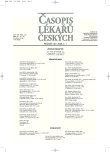The Use of Quantitative Assessment of Wilms Tumour Gene for Monitoring of Residual Disease in Acute Myeloid Leukemia Patients
Authors:
J. Polák; J. Marková; J. Schwarz; J. Maaloufová; Z. Volková; J. Čermák; C. Haškovec
Authors‘ workplace:
Ústav hematologie a krevní transfuze, Praha
Published in:
Čas. Lék. čes. 2006; 145: 36-42
Category:
Original Article
Overview
Background.
Despite a considerable effort, the majority of acute myeloid leukaemia (AML) patients do not have a suitable specific molecular marker for monitoring minimal residual disease (MRD). The results of some studies suggest the Wilms tumour gene (WT1) as a possible molecular marker of MRD.
Methods and Results.
We measured the expression of WT1 at diagnosis and during treatment of the acute myeloid leukaemia (AML) patients. The expression of WT1 was measured by the quantitative real-time RT-PCR in peripheral leukocytes from 56 AML at diagnosis and 7 patients with AML transformed from myelodysplastic syndromes (MDS). The WT1 expression was significantly elevated (up to 3 orders of magnitude) in peripheral blood samples (PB) of AML patients at diagnosis compared to PB samples of healthy donors (P<0.0001). The level of WT1 expression depends particularly on FAB AML subtype, with the highest being found in AML patients with subtypes M4, M1, M3 and AML transformed from MDS. Conversely, AML patients with M2 and with the presence of AML1/ET0 at presentation showed a significantly lower expression of the WT1 gene compared to the remaining AML patients at presentation (P = 0,005). Further, sequence samples of 12 AML patients under long-term surveillance were tested for the WT1 expression in parallel with the expression of specific MRD markers - fusion genes: AML1/ETO, PML/RARα and CBFB/MYH11. The levels of WT1 gene expression and the above specific fusion genes significantly correlated. Moreover, 14 patients without the specific MRD marker were tested for the WT1 expression. The results show that haematological relapses were associated with the rise of expression of the specific fusion genes and with the WT1 gene expression. The rise of WT1 expression above the level seen in leucocytes from peripheral blood and/or bone marrow of healthy donors – in four patients under long-term surveillance the „molecular relapse” predicted ongoing haematological relapses as early as 2 months in advance.
Conclusions.
Our results, in accordance with some of the previously published ones, show that WT1 expression seems to be a suitable marker of minimal residual disease in AML patients.
Key words:
leukemia, acute myeloid leukaemia, Wilms tumor 1, minimal residual disease.
Labels
Addictology Allergology and clinical immunology Angiology Audiology Clinical biochemistry Dermatology & STDs Paediatric gastroenterology Paediatric surgery Paediatric cardiology Paediatric neurology Paediatric ENT Paediatric psychiatry Paediatric rheumatology Diabetology Pharmacy Vascular surgery Pain management Dental HygienistArticle was published in
Journal of Czech Physicians

Most read in this issue
- Impact Factor – Good Servant, but a Bad Master
- Acute Toxicity of High Dose Interstitial Brachytherapy Boost in Prostate Cancer
- Abuse of Buprenorphine Becomes a Problem of the Czech Republic
- Principle and Importance of Using the Array CGH in Hematooncology
